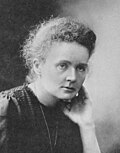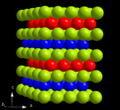Curium
Curium is a synthetic chemical element with the symbol Cm and atomic number 96. It is a member of the actinide series, and it is the third element that is named after a scientist, specifically Marie and Pierre Curie. Curium was first produced and identified in July 1944 by the group of Glenn T. Seaborg at the University of California, Berkeley.
History[edit]
The discovery of curium, as well as americium, in 1944 was closely related to the Manhattan Project as the scientists were searching for possible steps to produce a plutonium bomb. Curium was first identified in the fallout from the nuclear explosion of the first hydrogen bomb, Ivy Mike, in 1952. The symbol for curium, Cm, and its atomic number, 96, were chosen by its discoverers, Glenn T. Seaborg, Ralph A. James, and Albert Ghiorso.
Characteristics[edit]
Curium is a hard, brittle, silvery metal with a relatively high melting point and boiling point. It is a radioactive element and is one of the most hazardous to human health. Curium has a complex chemistry, forming various types of compounds, including oxides, halides, and salts.
Applications[edit]
Due to its intense radioactivity, curium has few applications. It is used in the production of heavier actinides and in the medical field as a power source for pacemakers. It is also used in space missions as a power source in radioisotope thermoelectric generators.
Health effects[edit]
Curium poses significant health risks due to its radioactivity. If ingested or inhaled, it can cause serious damage to health, including cancer and death. Therefore, it must be handled with great care, using appropriate safety measures.
See also[edit]
References[edit]
<references />
|
|
|
Curium gallery[edit]
-
Glenn Seaborg - 1964
-
Berkeley 60-inch cyclotron
-
Marie Curie (Nobel-Chem)
-
Pierre Curie
-
Closest packing ABAC
-
Cm(HDPA)3·H2O PL 420 nm
-
Curium-248
-
Sasahara
-
Ivy Mike - mushroom cloud
-
Elutionskurven Tb Gd Eu und Bk Cm Am
Ad. Transform your life with W8MD's Budget GLP-1 injections from $75


W8MD offers a medical weight loss program to lose weight in Philadelphia. Our physician-supervised medical weight loss provides:
- Weight loss injections in NYC (generic and brand names):
- Zepbound / Mounjaro, Wegovy / Ozempic, Saxenda
- Most insurances accepted or discounted self-pay rates. We will obtain insurance prior authorizations if needed.
- Generic GLP1 weight loss injections from $75 for the starting dose.
- Also offer prescription weight loss medications including Phentermine, Qsymia, Diethylpropion, Contrave etc.
NYC weight loss doctor appointmentsNYC weight loss doctor appointments
Start your NYC weight loss journey today at our NYC medical weight loss and Philadelphia medical weight loss clinics.
- Call 718-946-5500 to lose weight in NYC or for medical weight loss in Philadelphia 215-676-2334.
- Tags:NYC medical weight loss, Philadelphia lose weight Zepbound NYC, Budget GLP1 weight loss injections, Wegovy Philadelphia, Wegovy NYC, Philadelphia medical weight loss, Brookly weight loss and Wegovy NYC
|
WikiMD's Wellness Encyclopedia |
| Let Food Be Thy Medicine Medicine Thy Food - Hippocrates |
Medical Disclaimer: WikiMD is not a substitute for professional medical advice. The information on WikiMD is provided as an information resource only, may be incorrect, outdated or misleading, and is not to be used or relied on for any diagnostic or treatment purposes. Please consult your health care provider before making any healthcare decisions or for guidance about a specific medical condition. WikiMD expressly disclaims responsibility, and shall have no liability, for any damages, loss, injury, or liability whatsoever suffered as a result of your reliance on the information contained in this site. By visiting this site you agree to the foregoing terms and conditions, which may from time to time be changed or supplemented by WikiMD. If you do not agree to the foregoing terms and conditions, you should not enter or use this site. See full disclaimer.
Credits:Most images are courtesy of Wikimedia commons, and templates, categories Wikipedia, licensed under CC BY SA or similar.
Translate this page: - East Asian
中文,
日本,
한국어,
South Asian
हिन्दी,
தமிழ்,
తెలుగు,
Urdu,
ಕನ್ನಡ,
Southeast Asian
Indonesian,
Vietnamese,
Thai,
မြန်မာဘာသာ,
বাংলা
European
español,
Deutsch,
français,
Greek,
português do Brasil,
polski,
română,
русский,
Nederlands,
norsk,
svenska,
suomi,
Italian
Middle Eastern & African
عربى,
Turkish,
Persian,
Hebrew,
Afrikaans,
isiZulu,
Kiswahili,
Other
Bulgarian,
Hungarian,
Czech,
Swedish,
മലയാളം,
मराठी,
ਪੰਜਾਬੀ,
ગુજરાતી,
Portuguese,
Ukrainian











